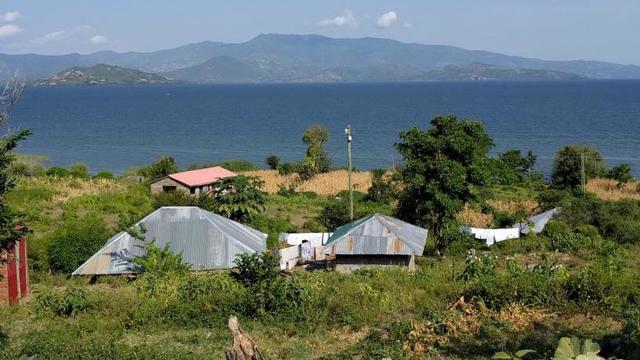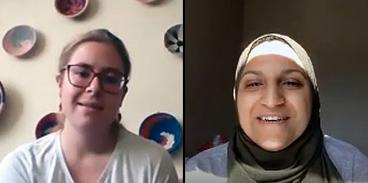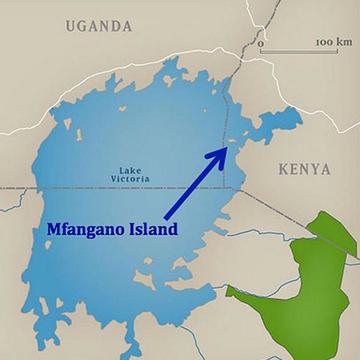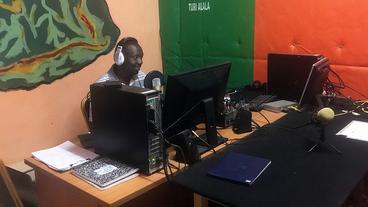It was a most unusual summer project for two students at the Humphrey School of Public Affairs—spanning two continents, 10 time zones, and an ocean—to deliver important public health information about the coronavirus pandemic to an isolated island population in Kenya.
But the students, who are pursuing their Master of Development Practice degrees, took on and succeeded in that challenge.
Aimee Carlson and Neamatallah Elsayed (both MDP ‘21) collaborated with several partner organizations to create and implement a COVID-19 information campaign for the 30,000 or so residents on Mfangano Island, situated in the eastern part of Lake Victoria about 10 miles off the coast of Kenya. And they did it all over Zoom.
The MDP program prepares students for careers in international development, equipping them with the skills needed to address issues such as poverty, social justice, and sustainable development. Students are required to complete a 10-week international field experience during the summer between the first and second year of the program. Because of the pandemic, students couldn’t travel to other countries, so they had to modify their projects into virtual formats.
In Carlson and Elsayed’s case, that meant their project pivoted to the pandemic from its original objective, which was to use Mfangano Island’s radio station to help preserve the residents’ endangered Suba language and the oral history of their culture.
Instead, they worked with a diverse group of partners to produce radio programs that provided the island community with accurate health information about COVID-19.
The partners included a nonprofit community health organization called Organic Health Response (OHR), Master of Public Health (MPH) students from the University of Minnesota and Maseno University in Kenya, and six radio presenters who work at the station.
University of Minnesota physician Dr. Chas Salmen is one of the main figures behind the partnership, which brought all these entities together to establish the Mfangano Community Health Field Station several years ago. The island radio station is one part of that community center.
“When the coronavirus hit, we recognized a need in the remote communities for good and accurate information about the pandemic, to combat the disinformation that was being spread,” Salmen says. ”People were hungry for accurate information. The MDP students quickly got on board with developing the radio broadcasts about COVID [to provide] basic health information, how to care for infected individuals, and so on.”
As of a few months ago, there were no cases of COVID on the island, in part because it’s so isolated, says Elsayed.
“Being isolated is a blessing and a curse,” she says. Not many outsiders—who could potentially bring the virus along with them—visit the island. “But if the coronavirus did reach the island it would be especially difficult for the population to manage since they don’t have a lot of health care available to them. There’s a large elder population, and about 30 percent of the residents have HIV.”
The daily hour-long talk show on the island’s radio station EK-FM began in July. It was called “Wanyalo Loyo Korona Kanyakla” or “We Can Face Corona Together,” and covered a different theme each week.
The Humphrey School students had online meetings with their partners on a weekly basis, so they had to coordinate schedules to cover the time differences between Kenya, Egypt (where Elsayed lived during the summer), Minnesota, and California (where the executive director of the OHR lives).
“The public health students developed weekly bulletins on various topics related to the coronavirus, and we adapted some of their information for the radio programs,” says Carlson. “A public health student from Maseno University reviewed our radio content to make sure that we provided accurate information and weren’t spreading rumors.”
Carlson and Elsayed virtually trained the radio presenters on how to develop the radio content, find reliable resources, and create graphics for social media to engage the audience. They produced the content for the first three topics, and then guided the radio team to create the content for two additional topics.
Radio is a crucial tool for disseminating news and information in many countries in Africa and around the world, and it was an effective strategy on Mfangano Island, according to Elias Pande, a public health student from Maseno University in Kenya who was one of the collaborators.
“Through the audience questions and feedback we were receiving, we saw that the number of listeners was increasing over time,” Pande says. “In addition, the public health [educators] on the ground were seeing people washing their hands and wearing face masks. They found that many people had heard the messages communicated by the radio presentations. The programs really captivated the community there.”
Getting to that point was not easy, though. In addition to the distance and time difference, the students dealt with sometimes spotty internet connections to the island, and limited access to technology for some of the radio staff.
“Not everyone had a smartphone or a laptop, so it was hard for them to join in our weekly planning meetings. Some would share a phone or they couldn’t join in at all,” says Elsayed. “It was also hard to get radio guests to the island because of the travel restrictions and limited PPE supplies. For me, not being there on the ground was a huge deal. We couldn’t get a feel for the situation.”
Despite all those challenges, the collaborators were pleased with the results. Dr. Lily Muldoon, executive director of OHR, says she was impressed by Carlson and Elsayed’s ability to adapt quickly to the new direction of the project.
“They worked really well with the Kenyan team, and thought of ways to push things forward working with the community,” Muldoon says. “They also demonstrated cultural sensitivity while talking about some sensitive issues, and they were thoughtful and understanding of the audience. It’s exciting that we were still able to have a successful project despite the COVID restrictions.”
Lessons learned
Although this specific summer project is now finished, the collaborative work is continuing. Carlson and Elsayed, along with two other students, are doing a capstone project, which they will finish in the spring, based on their experience working with the island radio station.
“Their capstone project will look more broadly at how community-based radio can be used most effectively as a vehicle for community development, education, and change, on Mfangano Island and in other global communities,” says Dave Wilsey, director of the MDP program. Based on that research, another team of students will likely spend next summer working on a related project.
One word that best summarizes Carlson and Elsayed’s summer experience is flexibility. Given the changing nature of their project, and their long-distance management of it, “we learned the importance of being flexible in our work, and improvising and learning as we went along,” Elsayed says.
Carlson adds: “We learned to be more humble. When you can’t go there in person, you depend on someone else to get things done. I recognize through this the importance of local expertise. It should be the community’s project, and giving over that control is a good lesson to learn.”





